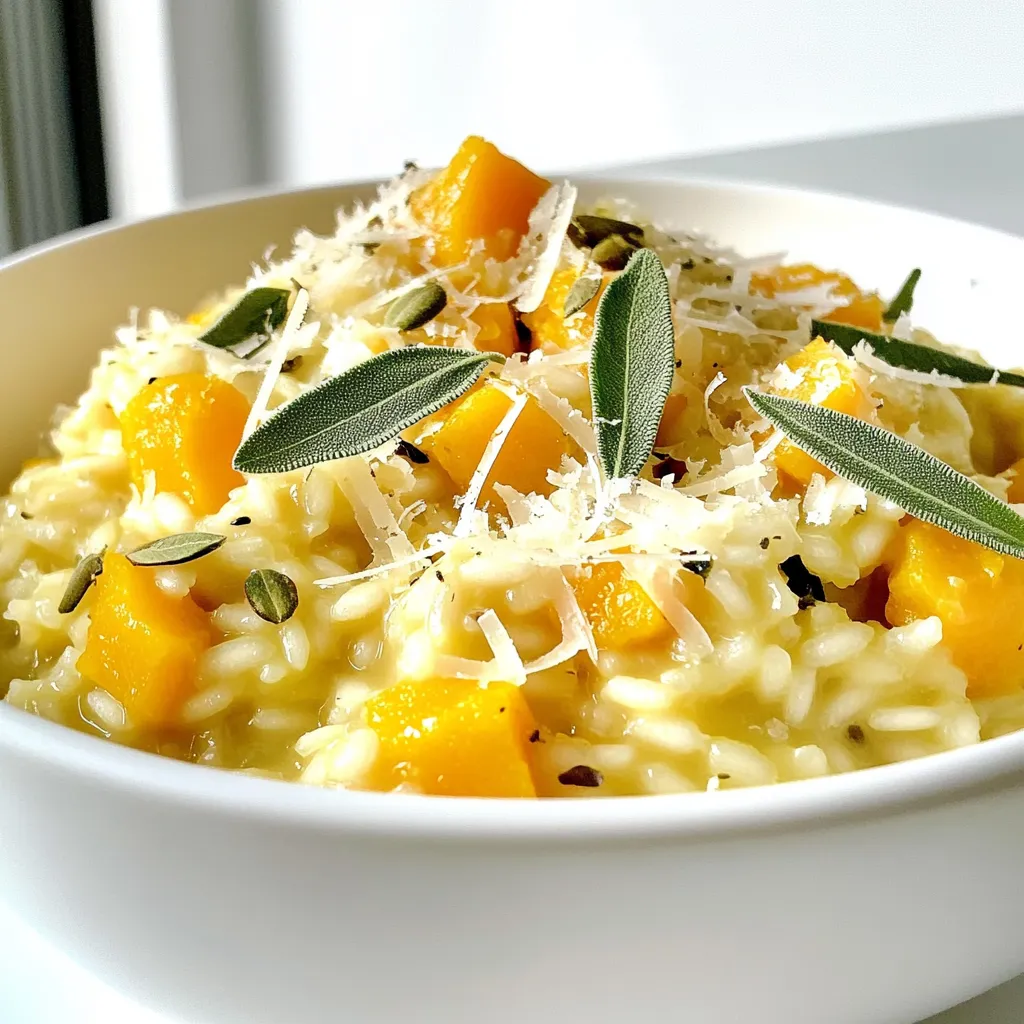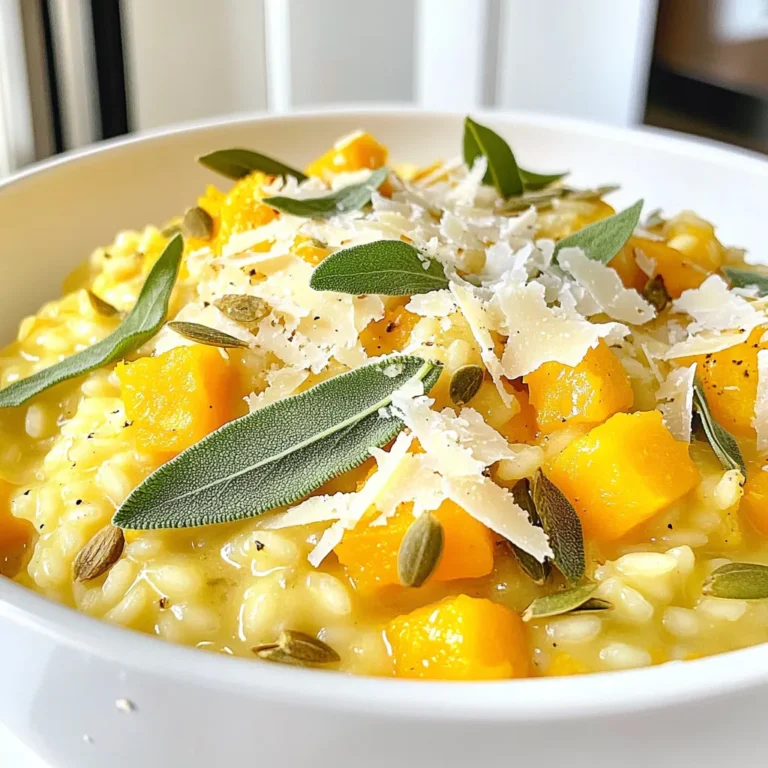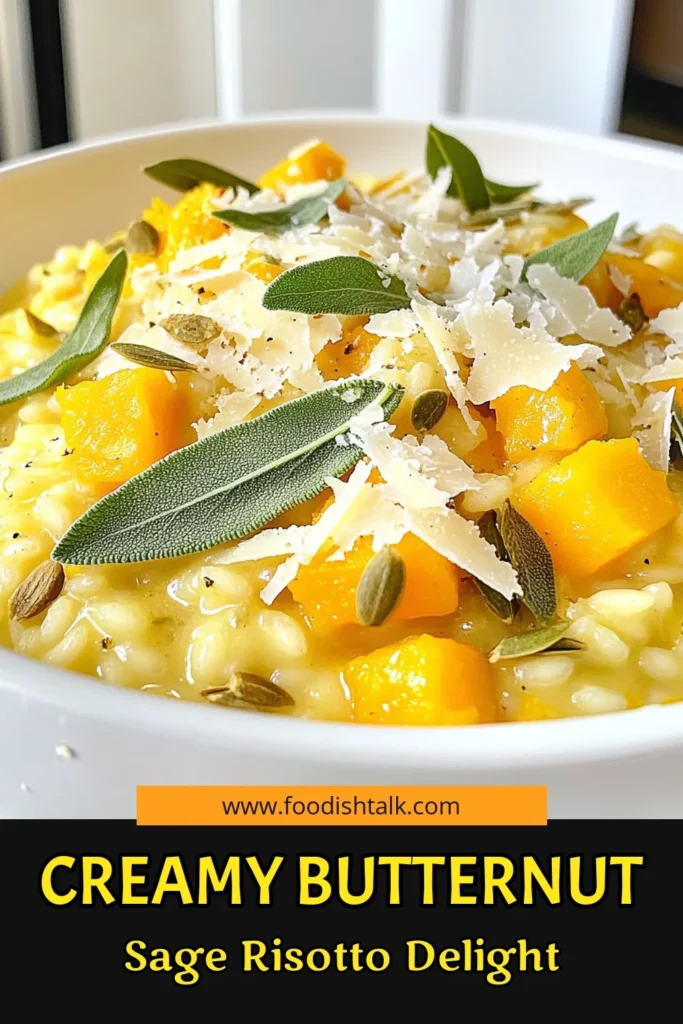If you’re craving a warm, filling dish, you must try this Butternut Squash Sage Risotto. This savory and simple recipe combines creamy risotto with rich flavors from butternut squash and fresh sage. You’ll enjoy each spoonful. I’ll guide you through easy steps to make this dish perfect every time. Get ready to impress yourself and your dinner guests with a meal that warms the heart! Let’s dive in.
Ingredients
To make Butternut Squash Sage Risotto, you need a few simple ingredients. Here’s a list for easy reference:
– 1 cup Arborio rice
– 2 cups butternut squash, diced
– 4 cups vegetable broth
– 1 small onion, finely chopped
– 2 cloves garlic, minced
– 1 tablespoon fresh sage, chopped
– 1 tablespoon olive oil
– 1 tablespoon butter
– 1/2 cup grated Parmesan cheese
– Salt and pepper to taste
– Optional: Toasted pumpkin seeds for garnish
Each ingredient plays a key role. The Arborio rice gives the dish its creamy texture. The butternut squash adds sweetness and color. Vegetable broth provides a rich base. Onion and garlic build a solid flavor foundation. Fresh sage brings an earthy note. Olive oil and butter add richness. Parmesan cheese finishes the dish with depth. Finally, salt and pepper bring all the flavors together.
Feel free to adjust the ingredients based on your taste. You can add more squash for sweetness or extra cheese for creaminess. Each choice makes the risotto your own.
Step-by-Step Instructions
Preparing the Vegetable Broth
First, grab a saucepan. Pour in your vegetable broth and heat it over low heat. This keeps the broth warm while you cook. Warm broth helps the rice cook evenly and absorb flavors better. You want it ready when you need it.
Sautéing Onion and Garlic
Next, take a large skillet. Add olive oil and butter, then heat over medium. Once hot, toss in the finely chopped onion. Sauté it for about three to four minutes until it turns soft and clear. Now, add the minced garlic. Cook for another minute until it smells great. The onion and garlic form a tasty base for your risotto.
Cooking Butternut Squash and Rice
Now, it’s time for the butternut squash. Add the diced squash to the skillet. Cook it for five to six minutes until it softens a bit. Then, stir in your Arborio rice. Toast the rice for one to two minutes. This step makes the rice slightly clear and brings out its flavor.
Adding Broth and Finalizing Risotto
Here comes the fun part. Start adding the warm vegetable broth to the rice. Use a ladle and add one scoop at a time. Stir it well and wait until the rice absorbs most of the liquid before adding more. Keep doing this for about 20 to 25 minutes. The rice should be creamy and al dente when done. Mix in the chopped sage and grated Parmesan cheese. Season with salt and pepper to make it just right.
Garnishing and Serving Suggestions
Once your risotto is ready, let it sit for two to three minutes to thicken. Serve it hot. For an extra touch, sprinkle toasted pumpkin seeds on top. They add a nice crunch and look great on the plate. Enjoy your delicious butternut squash sage risotto!
Tips & Tricks
Choosing the Right Rice for Risotto
When making risotto, use Arborio rice. This rice has high starch content. Starch helps create a creamy texture. Other types of rice, like long-grain, won’t work well. Arborio rice absorbs liquid and flavors nicely. This makes it perfect for risotto dishes.
How to Achieve Creamy Texture
To get that creamy texture, stir often. Add broth slowly, one ladle at a time. Wait until the rice drinks the broth before adding more. This slow cooking helps release starch. The starch is what gives risotto its rich, creamy feel. You can also add butter and cheese at the end. This adds extra creaminess and flavor.
Enhancing Flavor with Herbs and Spices
Sage is a great choice for this dish. Fresh sage brings warmth and depth. You can also try adding thyme or rosemary for more flavor. Just a pinch of nutmeg can add a nice twist. Taste as you go to find the right balance.
Recommended Cooking Utensils
Use a wide, shallow skillet or pan. This helps heat the rice evenly. A wooden spoon is best for stirring. It won’t scratch your pan and gives good control. Finally, a ladle is great for adding broth. These tools make cooking easier and more fun.

Variations
Adding Protein Options (e.g., Chicken, Shrimp)
You can easily add protein to this risotto. For chicken, use cooked, diced pieces. Stir them in at the end for a hearty meal. Shrimp is another great choice. Sauté shrimp in olive oil until pink. Mix them in right before serving. Both options boost flavor and make the dish filling.
Vegetarian and Vegan Adaptations
This risotto is simple to adapt for vegetarian or vegan diets. To make it vegetarian, replace butter with more olive oil and use vegetarian broth. For a vegan version, skip the Parmesan cheese or use a vegan alternative. Nutritional yeast adds a cheesy flavor without dairy.
Alternative Vegetable Ingredients (e.g., Peas, Spinach)
Feel free to swap in other vegetables. Peas add sweetness and color. Stir them in during the last few minutes of cooking. Spinach is another tasty option. Add fresh spinach right before serving. Both choices keep the dish light and nutritious. You can mix and match to find your favorite combination!
Storage Info
How to Store Leftover Risotto
To store leftover risotto, let it cool first. Once cool, place it in an airtight container. Make sure to cover it well to keep it fresh. Risotto can stay good in the fridge for up to three days. If you want it to last longer, consider freezing it.
Reheating Tips for Optimal Texture
When reheating risotto, add a splash of broth or water. This keeps the rice creamy. Use a saucepan over low heat. Stir often to avoid sticking. You can also microwave it, but add liquid in small amounts. Heat in short bursts and stir in between for the best result.
Freezing Risotto: Steps and Tips
To freeze risotto, portion it into smaller containers. Let it cool completely before sealing. This helps keep the texture. It can last for up to three months in the freezer. When you are ready to eat, thaw it in the fridge overnight. Reheat as mentioned earlier for a creamy dish.
FAQs
What is the main difference between Arborio rice and regular rice?
Arborio rice is a short-grain rice. It has a high starch content. This gives risotto its creamy texture. Regular rice, like long-grain, does not have this starch. It stays separate when cooked. For a creamy dish, always choose Arborio rice.
Can I use frozen butternut squash for this recipe?
Yes, you can use frozen butternut squash. It saves time and is convenient. Just thaw it before adding to the risotto. This way, it cooks evenly with the other ingredients. Fresh squash is great, but frozen works well too.
How can I make risotto vegan?
To make this risotto vegan, swap the butter with more olive oil. Use nutritional yeast instead of Parmesan cheese. This adds a cheesy flavor without dairy. Ensure your vegetable broth is vegan-friendly. It’s easy to enjoy a tasty vegan risotto!
How long will leftover risotto last in the fridge?
Leftover risotto lasts about 3 to 5 days in the fridge. Store it in an airtight container. Make sure it cools down before sealing. Always check for any signs of spoilage before eating. Reheat it carefully to keep its creamy texture.
Can I make risotto ahead of time?
You can make risotto ahead of time. However, it’s best served fresh. If you prepare it early, leave it slightly undercooked. When reheating, add a bit of broth to restore creaminess. Enjoy your risotto with the same great taste!
In this blog post, we explored how to make a delicious butternut squash risotto. We covered the essential ingredients, step-by-step instructions, helpful tips, and various adaptations. Risotto is a tasty dish that can fit many diets. Remember to choose quality ingredients for the best flavor. Store leftovers properly, and don’t be afraid to get creative with add-ins. Enjoy making this comforting meal that warms your heart and plate!



